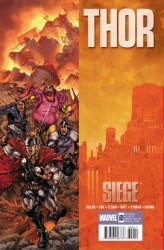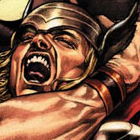![]()
How are the Asgardians reacting to the Siege? Find out after the jump
![]()
 Thor #609
Thor #609
Writer: Kieron Gillen
Art: Billy Tan & Batt, Rich Elson
Colours: Christina Strain, June Chung
Letters: Joe Sabino
Editor: Ralph Macchio
Cover: Mico Suayan & Laura Martin
Publisher: Marvel Comics
Previously on Thor: Asgard is under siege, and the forces of Norman Osborne have an undue advantage in the form of the Norn Stones – powerful Asgardian artifacts. Tyr, god of war, enters into a last-ditch confrontation against The Hood, but it does not appear to end well. Volstagg is attacked by Ragnarok – Thor’s psychotic android-clone – who is crushed as Asgard falls to the ground. Meanwhile, Asgardian Kelda visits the mortal family of her dead love to tell them the bad news, but she is tracked down by a HAMMER task force.
After the Fall
We begin this issue with Kelda facing off with the task force – they open fire and she appears to have been downed. Volstagg climbs out of the ruins of Asgard whilst Tyr is revealed to have survived. King Balder and Heimdall find Loki, and thus learn that Thor is not guilty of the crime for which he was exiled. Kelda, whilst initially suicidal with grief, is reassured by Bill’s mother and resolves to fight. Volstagg sets out to apprehend ‘those most sorely in need of judgement’ and Loki is questioned as to his actions during the Siege, but denies working with Osborne. Balder rallies the forces of Asgard, and Loki is exiled.
It is likely obvious from the plot summary that this issue can be split into three sub-plots. In order of panel-time: the Asgardians rally in their ruined city, Kelda faces the HAMMER task force, and Volstagg doesn’t do an awful lot. This splitting of the action means that each sub-plot moves along at a fast speed (relative to the space given to it), and one is certainly not left wanting for volume of story in this issue. Whilst in some books this might create problems with the pacing, the high speed of the plot suits the idea that there is a siege going on – a high-octane event that leaves no time for rest.
Get down to the nitty gritty, though, and the dialogue in the Balder/Loki scenes is cause for concern. It can be quite confusing, and I fear not in a deliberate way. It is frequently difficult to decipher exactly what the two are saying and, whilst I could understand Loki’s dialogue being cryptic, the other characters seem to follow him just fine; this creates a loop that only the reader is left out of, leading me to believe that the dialogue is at fault. However, once one does work out what is happening in these scenes, they are rewarded with some nice character moments for both Balder and Loki. Balder is faced with a dilemma: he knows now that Thor is innocent, but if he pardons him he will loose his throne. Loki appears to actually show regret at what has happened to Asgard, lamenting the fact that he does not know why he creates such mischief, but that it is simply in his nature. It’s a compelling panel, made all the more so by the fact that even as he decries his penchant for trickery, Loki is still lying to his fellow Asgardians about his involvement with Osborne.
Dialogue issues aside, the Asgardian plot is quite gripping, and the other two sub-plots are both well-written and draw no complaints from me. My only other major problem with this issue is that, for a book bearing his name, it doesn’t feature Thor at all. I can’t complain too much about this, however: I’m sure Thor is being kept busy by the events of the main Siege title, and this issue still focuses on important characters in his mythos. All in all, this is a good Thor-related story.
A Problem Shared is Not Always a Problem Halved
The art is split between the art/colour teams of Billy Tan & Batt/Christina Strain (pages 3-4, 8-9, 14-22) and Rich Elson/June Chung (pages 1-2, 5-7, 10-13), with Elson/Chung drawing the Kelda scenes and the first Asgardian scene (in which it is established that Tyr survived), and Tan & Batt/Strain providing the Volstagg and other Asgardian scenes. I’d say that the Elson/Chung art looks a bit softer than it’s counter-part, which rather befits Kelda’s femininity (although she’s not afraid to kick ass), and it also seems less inclined to provide us with backgrounds. Both styles are pretty similar, however, and if you’d told me that the whole book was done by one artist I’d have no trouble believing it.
The art, then, is very nice and perfectly functional – it’s everything one would expect from a big super hero title such as this. That’s just the thing, though: it’s rather uninspired. It’s pretty enough and shows us everything that needs showing, but there’s nothing particularly unique about it, nothing to differentiate it from so much other super hero art that can be seen today. That said, it does have it’s moments: the panel in which Loki laments his treacherous nature has him pulling a brilliant expression – his frustration and anger is written all over his face, and his eyes are particularly expressive. However, a big criticism of mine also concerns Loki: in the final panel there is, to my mind, a large writing/art disconnect. Loki appears to be talking about saving Balder, despite being exiled, but the art shows him looking mischievous. It is difficult to discern the tone that this panel is trying to create; I have a feeling it’s an ominous one, but if I had read the dialogue in a purely textual form, I would have thought it sincere.
The cover also begs some discussion, although I aim this at all Siege titles: with all the epic things going on in this event– Asgard collapsing etc. – why is it that at least a third of every cover is obscured by a great big strip bearing the bland silhouette of a city-scape? It is even bigger in this issue, taking up half the book’s cover. I honestly cannot see the point of it, and it only serves to make the books look unappealing. The actual cover image for this issue consists of Thor etc. running towards the reader. The art is not my thing, and the image itself is rather uninspired and has nothing to do with the contents of the book. Finally, I actually have an issue with the lettering: there are a couple of noticeable errors, and I find that rare enough to be worth reporting.
Better than a Time-Share in Asgard
If you’ve been following the last two issues of Thor then you’re certainly going to want to pick this up: it has fair art, a good plot, and I find that this whole storyline definitely adds something to the overall Siege event. However, this is the third of a four part story and as such I cannot recommend it to any new readers. Overall, Thor #609 earns a solid three stars out of five and, if you haven’t been able to catch this current storyline, you may want to look out for any of Gillen’s further work on the series as it has been very enjoyable so far.



